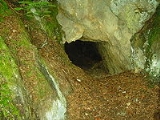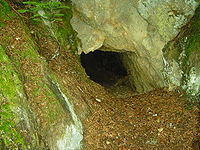
Lubietová
Encyclopedia
Ľubietová is a village in central Slovakia
. Originally an ancient mining town, it is known for precious minerals. It has less than 1,000 inhabitants.
in the Banská Bystrica Region
. It is situated 25 km east from the town of Banská Bystrica
. It lies at an altitude of 491 metres and covers an area of 61 km². The geographic center of Slovakia, the Hrb
mountain, is located near the village.
and less rich deposits of iron
ore, Ľubietová became soon an important center of medieval mining
industry. It was granted the status of a royal town in 1379 by Louis the Great and German
miners settled here. As one of the most important centers of Protestant Reformation in the country, the town created the Protestant "League of Seven Mining Towns" together with Banská Belá
, Banská Bystrica, Banská Štiavnica
, Kremnica
, Nová Baňa
, and Pukanec
. In 1692, the first modern blast furnace
in the Kingdom of Hungary
was built in Ľubietová. Due to the decline of the mining industry in the 18th century, the settlement lost its urban character and became a village.
 Ľubietová is famous for precious mineral
Ľubietová is famous for precious mineral
s that can be found inside the ancient mines. For example, Libethenite
was discovered there in 1823 and is named after the German
name of the village (Libethen). Euchroite
was also described for the first time in Ľubietová. The list of interesting minerals, mostly created by weathering of copper ores, also includes azurite
and malachite
.
, 98.5% of inhabitants were Slovaks
. The religious makeup was 60.2% Lutherans, 27% Roman Catholics, and 8.2% with no religious affiliation.
Slovakia
The Slovak Republic is a landlocked state in Central Europe. It has a population of over five million and an area of about . Slovakia is bordered by the Czech Republic and Austria to the west, Poland to the north, Ukraine to the east and Hungary to the south...
. Originally an ancient mining town, it is known for precious minerals. It has less than 1,000 inhabitants.
Geography
Ľubietová is part of the Banská Bystrica DistrictBanská Bystrica District
Banská Bystrica District is a district in the Banská Bystrica Region of central Slovakia. Until 1918, the area belonged to the county of Zvolen within the Kingdom of Hungary.-Municipalities:*Badín*Baláže*Banská Bystrica*Brusno*Čerín...
in the Banská Bystrica Region
Banská Bystrica Region
The Banská Bystrica Region is one of the Slovak regions in the country of Slovakia in Europe.-Geography:It is located in the central part of Slovakia and has an area of 9,455 km². The region is prevailingly mountains, with several ranges within the area. The highest of them are the Low Tatras...
. It is situated 25 km east from the town of Banská Bystrica
Banská Bystrica
Banská Bystrica is a key city in central Slovakia located on the Hron River in a long and wide valley encircled by the mountain chains of the Low Tatras, the Veľká Fatra, and the Kremnica Mountains. With 81,281 inhabitants, Banská Bystrica is the sixth most populous municipality in Slovakia...
. It lies at an altitude of 491 metres and covers an area of 61 km². The geographic center of Slovakia, the Hrb
HRB
HRB is a three-letter abbreviation with multiple meanings, including:* HRB * H&R Block, a U.S. tax preparation and personal finance management company* HRB Systems, a defense contractor...
mountain, is located near the village.
History
Thanks to abundant deposits of copperCopper
Copper is a chemical element with the symbol Cu and atomic number 29. It is a ductile metal with very high thermal and electrical conductivity. Pure copper is soft and malleable; an exposed surface has a reddish-orange tarnish...
and less rich deposits of iron
Iron
Iron is a chemical element with the symbol Fe and atomic number 26. It is a metal in the first transition series. It is the most common element forming the planet Earth as a whole, forming much of Earth's outer and inner core. It is the fourth most common element in the Earth's crust...
ore, Ľubietová became soon an important center of medieval mining
Mining
Mining is the extraction of valuable minerals or other geological materials from the earth, from an ore body, vein or seam. The term also includes the removal of soil. Materials recovered by mining include base metals, precious metals, iron, uranium, coal, diamonds, limestone, oil shale, rock...
industry. It was granted the status of a royal town in 1379 by Louis the Great and German
Germans
The Germans are a Germanic ethnic group native to Central Europe. The English term Germans has referred to the German-speaking population of the Holy Roman Empire since the Late Middle Ages....
miners settled here. As one of the most important centers of Protestant Reformation in the country, the town created the Protestant "League of Seven Mining Towns" together with Banská Belá
Banská Belá
Banská Belá is a village and municipality in Banská Štiavnica District, in the Banská Bystrica Region of central Slovakia. It has a population of 1,234.-History:...
, Banská Bystrica, Banská Štiavnica
Banská Štiavnica
Banská Štiavnica is a town in central Slovakia, in the middle of an immense caldera created by the collapse of an ancient volcano. For its size, the caldera is known as Štiavnica Mountains. Banská Štiavnica has a population of more than 10,000. It is a completely preserved medieval town...
, Kremnica
Kremnica
Kremnica is a town in central Slovakia. It has some 5,700 inhabitants. The well-preserved medieval town built above important gold mines is the site of the oldest still-working mint in the world.-History:...
, Nová Baňa
Nová Bana
Nová Baňa is a small town in the west of central Slovakia and the largest town of the Žarnovica District, located in the Banská Bystrica Region.- Geography :...
, and Pukanec
Pukanec
Pukanec anz, ; ) is a village and municipality in the Levice District in the Nitra Region of southern Slovakia.-History:In the past, it was one of the nine free royal mining towns, where silver and other precious ore was mined....
. In 1692, the first modern blast furnace
Blast furnace
A blast furnace is a type of metallurgical furnace used for smelting to produce industrial metals, generally iron.In a blast furnace, fuel and ore and flux are continuously supplied through the top of the furnace, while air is blown into the bottom of the chamber, so that the chemical reactions...
in the Kingdom of Hungary
Kingdom of Hungary
The Kingdom of Hungary comprised present-day Hungary, Slovakia and Croatia , Transylvania , Carpatho Ruthenia , Vojvodina , Burgenland , and other smaller territories surrounding present-day Hungary's borders...
was built in Ľubietová. Due to the decline of the mining industry in the 18th century, the settlement lost its urban character and became a village.
Minerals

Mineral
A mineral is a naturally occurring solid chemical substance formed through biogeochemical processes, having characteristic chemical composition, highly ordered atomic structure, and specific physical properties. By comparison, a rock is an aggregate of minerals and/or mineraloids and does not...
s that can be found inside the ancient mines. For example, Libethenite
Libethenite
Libethenite is a rare copper phosphate hydroxide mineral. It forms striking, dark green orthorhombic crystals. It was discovered in 1823 in Ľubietová, Slovakia and is named after the German name of that locality .-References:...
was discovered there in 1823 and is named after the German
German language
German is a West Germanic language, related to and classified alongside English and Dutch. With an estimated 90 – 98 million native speakers, German is one of the world's major languages and is the most widely-spoken first language in the European Union....
name of the village (Libethen). Euchroite
Euchroite
Euchroite is a hydrated copper arsenate hydroxide mineral with formula: Cu2AsO4OH·3H2O. It is a vitreous green to emerald green mineral crystallizing in the orthorhombic system. It has a Mohs hardness of 3.5 - 4.0 and a specific gravity of 3.39 - 3.45. It was first described in 1823 in Ľubietová,...
was also described for the first time in Ľubietová. The list of interesting minerals, mostly created by weathering of copper ores, also includes azurite
Azurite
Azurite is a soft, deep blue copper mineral produced by weathering of copper ore deposits. It is also known as Chessylite after the type locality at Chessy-les-Mines near Lyon, France...
and malachite
Malachite
Malachite is a copper carbonate mineral, with the formula Cu2CO32. This green-colored mineral crystallizes in the monoclinic crystal system, and most often forms botryoidal, fibrous, or stalagmitic masses. Individual crystals are rare but do occur as slender to acicular prisms...
.
Population
In 2004, Ľubietová had a population of 986. According to the 2001 censusCensus
A census is the procedure of systematically acquiring and recording information about the members of a given population. It is a regularly occurring and official count of a particular population. The term is used mostly in connection with national population and housing censuses; other common...
, 98.5% of inhabitants were Slovaks
Slovaks
The Slovaks, Slovak people, or Slovakians are a West Slavic people that primarily inhabit Slovakia and speak the Slovak language, which is closely related to the Czech language.Most Slovaks today live within the borders of the independent Slovakia...
. The religious makeup was 60.2% Lutherans, 27% Roman Catholics, and 8.2% with no religious affiliation.

